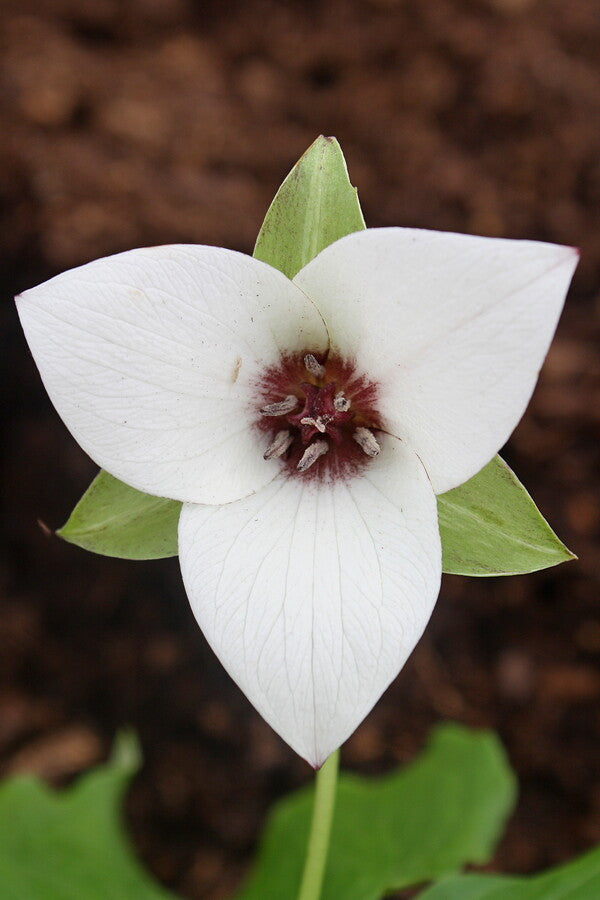The following article is part of a series geared toward entry-level gardeners. For deep dives into a variety of perennials that we have sold over the decades, visit our archive of in-depth perennial articles written by Tony Avent, Dr. Patrick McMillan, and other Plant Delights and JLBG experts. We also have transcripts of our Gardening Unplugged videos, recorded during our Open Nursery and Garden Days, that have great information for gardeners of all experience levels.
Trillium plants have a rich history that spans centuries. Belonging to the family Melanthiaceae, trilliums have captured the fascination of botanists, horticulturists, and nature enthusiasts alike. They have long been admired for their striking, three-petaled flowers, unique growth habits, and their ecological role in woodland ecosystems. Trilliums have a diverse distribution across North America, Asia, and Europe, with numerous species showcasing a wide range of colors and sizes. Over time, trilliums have become esteemed as symbols of natural beauty, resilience, and conservation, captivating generations with their elegance and inspiring ongoing efforts to protect and propagate these enchanting plants for future generations to appreciate. Here are some of the most common trillium related questions for those just getting started with this woodland perennial.
Trillium x flexatum white w/ dark eye
Are Trillium Plants Hard to Grow?
Trillium plants have specific growing requirements, and while they can be a bit challenging to cultivate, they are not inherently difficult to grow with the right knowledge and conditions. Trilliums are native to woodland environments and have adapted to specific ecological niches. They prefer well-draining, humus-rich soil with a slightly acidic pH. Trilliums thrive in moist, but not waterlogged, conditions and typically prefer shaded to partially shaded areas. Additionally, trilliums have a slow growth rate and may take several years to reach maturity and produce flowers. However, with proper care, including providing the appropriate growing conditions and being patient, trillium plants can be successfully grown in gardens or naturalized woodland settings.
Trillium foetidissimum 'Adams Family'
Where is the Best Place to Plant Trillium?
When selecting a site for planting trilliums, choose a location that offers dappled sunlight or filtered shade throughout the day, replicating their natural woodland habitat. Ensure the soil is well-draining and rich in organic matter, with a slightly acidic pH. Avoid areas prone to waterlogging or excessive moisture. Consider planting trilliums in groups or clusters to create a visually striking display. It is also essential to research the specific trillium species you are growing, as some may have unique preferences for light, moisture, or soil conditions.
How Long Does it Take for Trillium to Mature?
The growth rate of trillium plants can vary depending on the species, growing conditions, and cultivation methods. Trilliums are known for their slow growth, and it can take a few years for them to reach maturity and produce flowers. On average, it can take two to three years or even longer for trilliums to establish and bloom. Some species may take even longer. Patience is key when growing trilliums, as they require time to develop a strong root system and accumulate energy before they can devote resources to flowering. However, once established, trilliums can continue to grow and bloom year after year, rewarding your patience with their captivating beauty.
Trillium grandiflorum 'Graham'
Are Trilliums Invasive?
No, trilliums are not considered invasive plants. In fact, trilliums are native to various regions in North America, Asia, and Europe and are valued for their ecological importance and ornamental value. Trillium species have specific growing requirements and typically thrive in their natural woodland habitats. While they can spread naturally through seed dispersal, their growth is generally slow and not aggressive. Trilliums do not pose a threat to native ecosystems or crowd out other plant species. However, it's important to note that the term "trillium" encompasses a diverse group of species, and it's always best to research the specific trillium species in your region to ensure they are not classified as invasive in your area.
Why is it Important to Buy Ethically Propagated Trilliums?
It is crucial to buy only ethically propagated trillium plants to protect wild populations and their ecosystems, preserve genetic diversity, prevent the spread of diseases and invasive species, support responsible horticulture practices, and contribute to educational initiatives. By choosing ethically propagated trilliums, we actively promote sustainability, conservation, and a greater appreciation for native plant species, ensuring a healthier future for these captivating plants and the natural environments they inhabit. Here at Plant Delights Nursery and Juniper Level Botanic Garden, we only grow trillium from seed and never sell wild harvested trilliums.
Trillium ludovicianum 'Caldwell Silver'
In conclusion, delving into the most commonly asked questions about trillium plants has allowed us to dispel myths, clarify misconceptions, and provide valuable insights into their cultivation and care. Trilliums, with their delicate beauty and ecological significance, continue to captivate the hearts and minds of gardening enthusiasts and nature lovers alike. By understanding the specific requirements of trilliums, such as their preference for shaded environments, well-draining soil, and patience during their slow growth, we can successfully cultivate and appreciate these remarkable woodland treasures. By debunking popular myths and answering common queries, we hope to empower and inspire individuals to embrace the magic of trilliums, fostering a deeper connection with these enchanting plants and contributing to their conservation for generations to come.

